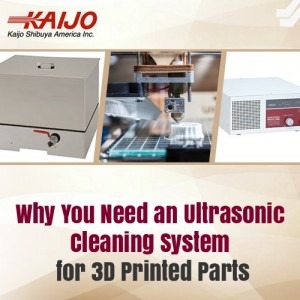Using an Ultrasonic Cleaning System for 3D Printed Parts
May 30, 2017
 Advances in 3D printing have made this new technology widely accessible with broad manufacturing capabilities. The 3D printers work by depositing tiny drops of material in thin layers according to a digital design. The material of the 3D part is usually a type of resin or plastic that is in liquid or paste form when it is deposited and then hardens into a solid. The printers make it possible to create items with complex shapes as prototypes or samples and they can be used to make test pieces before starting production.
Advances in 3D printing have made this new technology widely accessible with broad manufacturing capabilities. The 3D printers work by depositing tiny drops of material in thin layers according to a digital design. The material of the 3D part is usually a type of resin or plastic that is in liquid or paste form when it is deposited and then hardens into a solid. The printers make it possible to create items with complex shapes as prototypes or samples and they can be used to make test pieces before starting production.
Complex items may require several types of material and there may be overhangs, gaps or complicated structures. The 3D printer makes sure that overhangs and structures don’t collapse by depositing supporting material underneath. Some parts of the item may have to slide or rotate over, around or through other parts. For such parts, the printer deposits thin layers of separating material to make sure the sliding or rotating parts don’t stick together. When the item is finished, it may have several areas where such supporting or separating material is present. Before the 3D printed item can be used, the extra material must be removed.
Ultrasonic Cleaning Systems Can Clean 3D Printed Parts
Removing extra supporting and separating material from a 3D printed part quickly and effectively can be difficult. The layers to be removed are often thin and not easily accessible. Scrubbing or mechanical removal is time-consuming and can leave an unwanted residue. Using a specially formulated solvent to dissolve the material can require lengthy soaking times and result in incomplete removal. An ultrasonic cleaner is often an excellent solution for the cleaning of these parts and the removal of the unwanted material. Ultrasonic cleaners clean quickly and clean thoroughly, even around complex shapes and in hard-to-reach places.
An ultrasonic cleaning system works by using ultrasonic waves to generate cavitation bubbles in a cleaning liquid. The bubbles form and collapse in time with the frequency of the sound waves. This bubble action results in an intense scrubbing effect wherever the cleaning liquid touches the surface of the 3D printed item. If the cleaning liquid contains a solvent for the unwanted material or if the material is soft compared to the rest of the item, only the unwanted material will be removed.
Kaijo Ultrasonic Cleaners for Optimum Results
Kaijo’s ultrasonic cleaning systems can clean 3D printed parts and remove unwanted filler material quickly and effectively. The Phenix III turnkey system is ready to clean with a minimum of installation and set up work and is sized to handle most typical 3D printed items. The system operates at 26 kHz or 38 kHz and delivers 600 W or 1200 W of cleaning power.
For bigger 3D printed items, Kaijo ultrasonic generators, transducers and tanks can be used to set up special solutions aimed at a customer’s specific cleaning needs. The components can operate with the solvents needed for 3D printed parts cleaning and the transducers mounted in the tanks are rated for up to 100 degrees centigrade. When a customer has existing cleaning tanks to be re-used, Kaijo can help design custom configurations with multiple transducers to deliver excellent cleaning action in large tanks. Kaijo’s extensive experience with ultrasonic cleaning systems helps customers get the 3D cleaning performance they need. If you want a quote or free consultation on which ultrasonic cleaning systems should be used for your application call Kaijo or email info@kaijo-shibuya.com.





